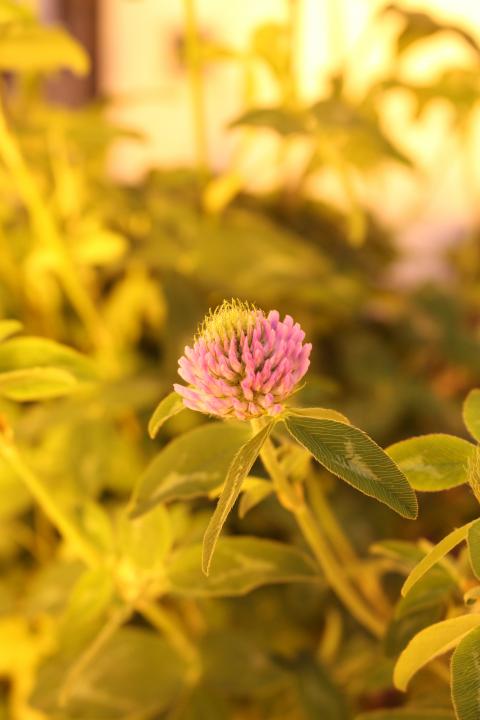SUREROOT A NOVEL APPROACH TO ROOT DESIGN
Extreme weather events like flooding and drought are becoming more prevalent as we feel the effects of climate change. Grasslands cover large land areas in the UK where rainfall tends to be highest. Many of our river catchments are upland grasslands in the wettest areas. To increase resilience to onsets of both droughts and floods, grass and clover breeders at IBERS are working to develop improved rooting structures that deliver improved water-use-efficiency, reduce soil compaction and aid efficient soil hydrology.
Scientists at Aberystwyth University's Institute of Biological, Environmental and Rural Sciences (IBERS), are working with Rothamsted Research to develop new drought-tolerant grasses and clovers that enable grassland soils to capture more rainfall and reduce the risk of flooding downstream. The project builds on research that showed that a Festulolium (ryegrass / fescue species’ combination) hybrid with a large root system that largely died back at depth during the autumn had potential for flood control. The Festulolium root-soil interactions instigated a change in soil structure leading to a 51% reduction in surface runoff compared to other grasses. Deep rooting structures also allow for better drought resistance during dry periods. It aims to exploit the vast genetic variation available within forage species to modify root dynamics to mitigate the effects of excess or deficient rainwater supply. IBERS is also developing grass and clover varieties with deeper root systems which can respond to drought stress by promoting root growth to access water deep in the soil. The enhanced root systems should improve soil structure, aid soil porosity and stabilise soils to prevent erosion.
To achieve this, genomic markers allied to genes for the relevant root structure traits will be identified and incorporated into new cultivars to both maintain agronomic performance and improve drought and flood tolerance. The effects of root growth and turnover on carbon deposition are being investigated and genome regions for root growth and turnover will be located and bred into high quality grass and clover varieties. Festulolium grasses are being grown at Rothamsted Research’s North Wyke farm platform facility measuring water and nutrient run-off levels. These fields are being grazed to understand the interaction between management and rooting structure. Data will also be gathered on soil structure and carbon content. Across the UK a network of commercial farms representing diverse soil type and livestock management systems will be exploring the use of the grasses and clovers resulting from the SUREROOT project.
The work on grasses includes perennial ryegrass and Festulolium. There are more than 500 species of fescue worldwide in temperate grasslands and they are very diverse depending on their origin. At farm level it is important when selecting a Festulolium in a ley seeds mix to know the parents and what they can in combination provide. A Festulolium of an Italian ryegrass combined with a meadow fescue (known as Festulolium braunii) will be very different in nature to a perennial ryegrass combined with a tall or Atlas fescue. The natural hybrid of perennial ryegrass and meadow fescue (Festulolium loliaceum) is already found in waterlogged soils, for example in mature water meadows. Currently there is just one Festulolium, ‘AberNiche’ on the UK National Recommended Varieties List where it is described as a hybrid ryegrass. AberNiche is an Italian ryegrass cross most suited to short term silage leys and compared to Italian ryegrass provides increased tolerance to both cold and dry weather conditions.
Work on legumes in SUREROOT focuses on three forage legume crops: red clover, white clover and a novel hybrid between the stoloniferous species white clover and the rhizomatous species Caucasian clover. Both grass and clover plants with substantially different root system architecture are being measured using state-of-the-art phenomics (precise and high-throughput image capture of above and below ground growth traits) and ‘traditional’ screening methods, tests on soils to measure the effects of contrasting root traits on soil permeability under different livestock management system, and assessments of their agronomic value under real field conditions. The aim of the clover research is to speed up the selection of genotypes with improved root systems for use in the white clover breeding programme, and to measure root-soil interactions by red clover which has deeper root systems than white clover. To include root trait analysis into the white clover breeding programme a previously constructed white clover gene-pool of genotypes of small/medium leaf sizes will be used that is being developed as part of the recurrent selection breeding programme. Improvement and understanding of legume root architecture and its effects on soils is a key part of the research. The legumes are being studied at fine scale in the phenomics unit through to ‘pipe scale’ root columns and field scale where yield and feed value is being estimated under simulated silage cuts as used under National list trials.
Putting it together
It is vital to check that variations in root growth and design are also seen when grasses and clovers are grown together in field scale conditions. Specific grass or clover root turnover can help soil structure, water, nutrient and carbon retention. The grasses and clovers are being grown in plots as mono cultures and in mixtures to explore any differences in the combinations and reflect farming practice. The holistic approach to the grass and clover breeding means that in addition to the benefits for flooding or droughting the animal production potential is being explored to ensure efficient livestock performance is maintained.
SUREROOT, a five-year £2.5 million LINK project, is funded by the Biotechnology and Biological Sciences Research Council (BBSRC) and match-funded by a range of industrial partners.

